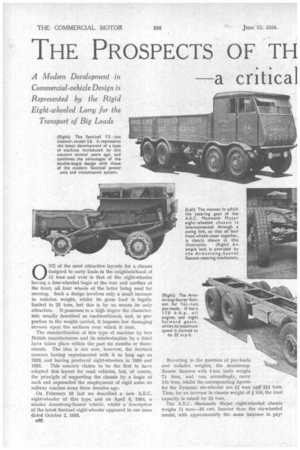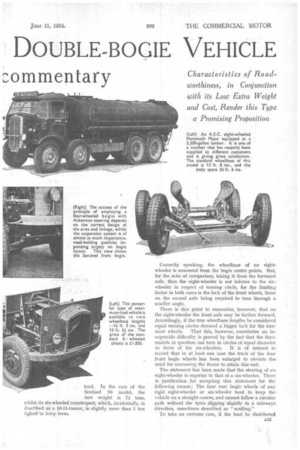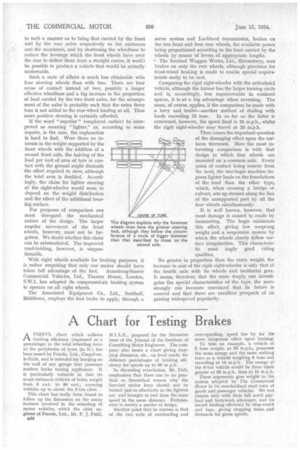THE PROSPECTS OF TH DOUBLE-BOGIE VEHICLE
Page 46

Page 47

Page 48

If you've noticed an error in this article please click here to report it so we can fix it.
—a critical zommentary
0 NE of the most attractive layouts for a chassis designed to carry loads in the neighbourhood of 12 tons and over is that of the eight-wheeler having a four-wheeled bogie at the rear and another at the front, all four wheels of the latter being used for steering. Such a design involves only a small increase in unladen weight, whilst its gross load is legally limited to 22 tons, but this is by no means its only attraction. It possesses to a high degree the characteristic usually described as roadworthiness, and, in proportion to the weight carried, it imposes low damaging stresses upon the surfaces over which it runs.
The standardization of this type of machine by two British manufacturers and its reintroduction by a third have taken place within the past six months or thereabouts. The idea is not new, however, the Sentinel concern having experimented with it so long ago as 1928, and having produced eight-wheelers in 1930 and 1931. This concern claims to be the first to have adopted this layout for road vehicles, but, of course, the principle of supporting the chassis by a bogie at each end superseded the employment of rigid axles on railway coaches some three decades ago.
On February 16 last we described a new A.E.C. eight-wheeler of this type, and on April 6, 1934, a similar Armstrong-Saurer vehicle, whilst a• description of the latest Sentinel eight-wheeler appeared in our issue dated October 2, 1933.
u32 Reverting to the queStion of pay-loads and unladen weights, the ArmstrongSaurer Samson with 1-ton body weighs 71tons, and can, accordingly, carry 141 tons, whilst the corresponding figures for the Dynamic six-wheeler are 0a tons and 124 tons. Thus, for an increase in chassis weight of ton; the load capacity is raised by 24 tons.
The A.E.C. Mammoth Major eight-wheeled chassis weighs 71tons-16 cwt. heavier than the six-wheeled model, with approximately the same increase in pay
load. In the case of the Sentinel S8 model, the tare weight is 7i tons, whilst its six-wheeled counterpart, which, incidentally, is described as a 10-11-tonner, is slightly more than 1 ton lighLdt in lorry form.
Correctly speaking, the wheelbase of an eightwheeler is measured from the bogie centre points. But, for the sake of comparison, taking it from the foremost axle, then the. eight-wheeler is not inferior to the sixwheeler in respect of turning circle, for the limiting factor in both cases is the lock of the front wheels, those on the second axle being required to turn through a smaller angle.
• There is this point to remember, however, that on the eight-wheeler the front axle may be farther forward. Accordingly, if the true wheelbase lengths be considered equal turning circles demand a bigger lock for the fore most wheels. That this, however, constitutes no insuperable difficulty is proved by the fat that the three models in question can turn in circles of equal diameter
to those of the six-wheelers. It is of interest to record that in at least one case the track of the four front bogie wheels has been enlarged to obviate ths need for narrowing the frame to attain this end.
The statement has been made that the steering of an eight-wheeler is superior to that of a six-wheeler. There is justification for accepting this statement for the following reason : The four rear bogie wheels of any rigid eight-wheeler or six-wheeler tend to keep the vehicle on a straight course, and cannot follow a circular path without the tyres slipping slightly in a sideways direction, sometimes described as " scuffing."
To take an extreme case, if the load be distributed )333 in such a manner as to bring that carried by the front and by the rear axles respectively to the minimum and the maximum, and by shortening the wheelbase to reduce the leverage which the front wheels have over the rear to deflect them from a straight course, it would be possible to produce a vehicle that would be actually unsteerable.
Such a. state of affairs is much less obtainable with four steering wheels than with two. There are four areas of contact instead of two, possibly a longer effective wheelbase and a big increase in the proportion of load carried by the two front axles, for the arrangement of the axles is probably such that the extra three tons is not added to the rear-wheel loading at all. Thus more positive steering is certainly afforded.
If the word " superior " (employed earlier) be interpreted as meaning " lighter,!' a's, according to some reports, is the case, the explanation is hard to find. Were there no increase in the weight supported by the front wheels with the addition of a second front axle, the halving of the load per unit of area of tyre in contact with the ground might diminish the effort required to steer, although the total area is doubled. Accordingly, the claim for lighter steering of the eight-wheeler would seem to depend on the weight distribution and the effect of the additional bearing surface.
For purposes of comparison one must disregard the mechanical nature of the design. The larger angular movement of the front wheels, however, must not be forgotten. We doubt whether this claim can be substantiated. The improved road-holding, however, is unquestionable.
With eight wheels available for braking purposes, it is rather surprising that only one maker should have taken full advantage of the fact. Armstrong-Saurer Commercial Vehicles, Ltd., Thames House, London, S.W.1, has adapted its compressed-air braking system to operate on all eight wheels.
The Associated Equipment Co., Ltd., Southall, Middlesex, employs the foot brake to apply, through a
111M11111.1 11/21
11■11._ servo system and Lockheed transmission, brakes on the two front and four rear wheels, the available power being proportioned according to the load carried by the wheels by means of levers of appropriate lengths.
The Sentinel Waggon Works, Ltd., Shrewsbury, uses brakes on only the rear wheels, although provision for front-wheel braking is made to enable special requirements easily to be met, Comparing the rigid eight-wheeler with the articulated vehicle, although the former has the larger turning circle and is, accordingly, less manceuvrable in confined spaces, it is at a big advantage when reversing. The same, of course, applies, if the comparison be made with a lorry and trailer—another method of dealing with loads exceeding 13 tons. In so far as the latter is concerned, however, the speed limit is 16 m.p.h., whilst the rigid eight-wheeler may 'travel at 20 m.p.h.
Then comes the important question of the damaging effect upon the surfaces traversed. Here the most interesting comparison is with that design in which four wheels are• mounted on a common axle. Every point of contact being remote from the next, the two-bogie machine imposes lighter loads on the foundations of the road than the other type, which, when crossing a bridge or culvert, sets up stresses along the line of the unsupported part by all the four wheels simultaneously.
It is well known, however, that most damage is caused to roads by hammering. The bogie minimizes this effect, giving low unsprung weight and a suspension system by which the wheels closely follow surface irregularities. This characteristic must imply good riding qualities.
No greater in proportion than the extra weight, the increase in cost of the rigid eight-wheeler is only that of the fourth • axle with its wheels and incidental gear. It seems, therefore, that the more deeply one investigates the special characteristics of the type, the more strongly one becomes convinced that its future is assured and that there are excellent prospects of its gaining widespread popularity.




























































































